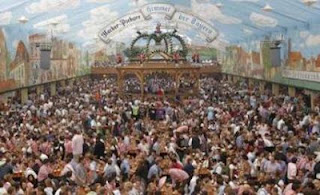 This is the Northern Brewer recipe for Guinness. This is Ireland's most popular and well-known beers, this stout has a pronounced roasty, coffee-like flavor and aroma, imparted by a generous helping of roasted barley.
This is the Northern Brewer recipe for Guinness. This is Ireland's most popular and well-known beers, this stout has a pronounced roasty, coffee-like flavor and aroma, imparted by a generous helping of roasted barley.Guinness (pron.: /ˈɡɪnɨs/ gin-is) originated in the brewery of Arthur Guinness (1725–1803) at St. James's Gate, Dublin. A feature of the product is the burnt flavour that is derived from roasted unmalted barley. For many years a portion of aged brew was blended with freshly brewed beer to give a sharp lactic flavour and fatures a characteristic "tang". The draught beer's thick, creamy head comes from mixing the beer with nitrogen when poured.
Prior to 1939 if a Guiness brewer wished to marry a Catholic girl, his resignation was requested.

13A. Dry StoutAroma: Coffee-like roasted barley and roasted malt aromas are prominent; may have slight chocolate, cocoa and/or grainy secondary notes.
Appearance: Jet black to deep brown with garnet highlights in color. A thick, creamy, long-lasting, tan- to brown-colored head.
Flavor: Moderate roasted, grainy sharpness, optionally with light to moderate acidic sourness, and medium to high hop bitterness. Dry, coffee-like finish from roasted grains. May have a bittersweet or unsweetened chocolate character in the palate, lasting into the finish. Balancing factors may include some creaminess, medium-low to no fruitiness, and medium to no hop flavor. No diacetyl.
Mouthfeel: Medium-light to medium-full body, with a creamy character. Low to moderate carbonation. For the high hop bitterness and significant proportion of dark grains present, this beer is remarkably smooth. The perception of body can be affected by the overall gravity with smaller beers being lighter in body. May have a light astringency from the roasted grains, although harshness is undesirable.
Overall Impression: A very dark, roasty, bitter, creamy ale.














